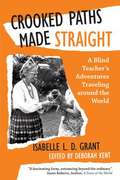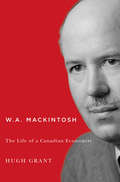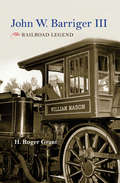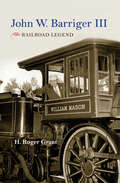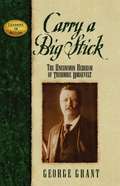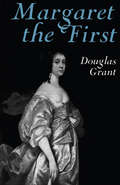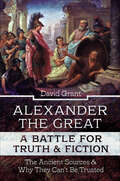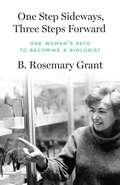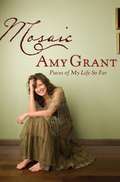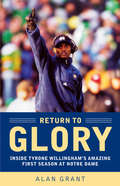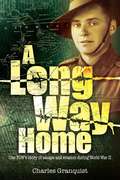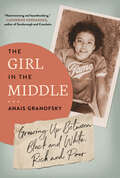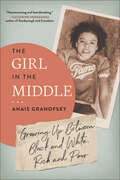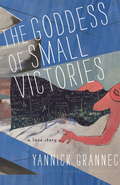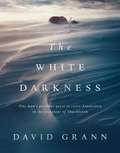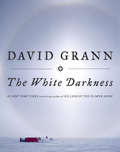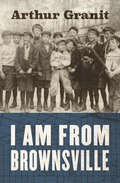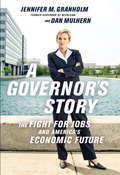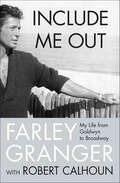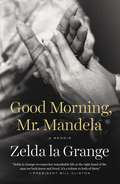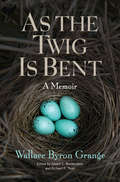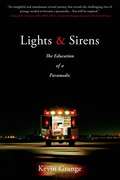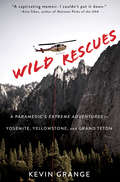- Table View
- List View
Crooked Paths Made Straight: A Blind Teacher's Adventures Traveling Around The World
by Isabelle L. D. Grant Deborah Kent<P>In 1959, two years before she retired from teaching, Dr. Isabelle Grant set off on a yearlong journey around the world with Oscar, her long white cane, in her hand. She had been totally blind for the past twelve years. <P>In Crooked Paths Made Straight, she shares the story of her journey during which she visited twenty-three countries from Great Britain to Fiji. In Karachi, she traveled the streets by rickshaw and struggled to master the Urdu language. In India, she explored the Taj Mahal, and in Burma she slept in a room where lizards raced up and down the walls. <P>At a time when both women and blind people were generally seen as too helpless for solo travel, Grant fearlessly defied conventions. A dedicated teacher with a lifelong commitment to learning, her mission was to learn all she could about education in the countries she visited, in particular the education provided to blind children. <P>Completed in 1965, Crooked Paths Made Straight recounts Grant's journey, a story of dreams deferred that did not shrivel but sprang to life again and again.
W.A. Mackintosh
by Hugh GrantW.A. Mackintosh (1895-1970) was an exemplary public intellectual and a modest person of rare abilities. In the first biography of this influential economist, Hugh Grant addresses how Mackintosh's commitment to public service and to the principles of reason and tolerance shaped his contribution to economic scholarship, government policy, and university governance. In the 1920s and '30s, Mackintosh emerged as the country's leading economist. His most notable contribution was through his "co-discovery" with Harold Innis of the staple thesis of Canadian economic development, which informed research in the field for a generation. During the Second World War Mackintosh joined the Department of Finance, where he played a central role in the successful management of the wartime economy and in Canada's adoption of Keynesian economic policy. As the author of the federal government's 1945 White Paper, Mackintosh laid out the broad strokes of Canada's adherence to Keynesianism in the post-war period. After his return to Queen's, Mackintosh would become the university's fifteenth principal and guide the institution as it prepared for the transformation of Canadian universities. A remarkable man who had a profound influence on the development of modern Canada, this definitive biography restores the record on his important contributions to Canadian economic thought and national and international finance.
W.A. Mackintosh: The Life of a Canadian Economist (Carleton Library Series)
by Hugh GrantW.A. Mackintosh (1895-1970) was an exemplary public intellectual and a modest person of rare abilities. In the first biography of this influential economist, Hugh Grant addresses how Mackintosh's commitment to public service and to the principles of reason and tolerance shaped his contribution to economic scholarship, government policy, and university governance. In the 1920s and '30s, Mackintosh emerged as the country's leading economist. His most notable contribution was through his "co-discovery" with Harold Innis of the staple thesis of Canadian economic development, which informed research in the field for a generation. During the Second World War Mackintosh joined the Department of Finance, where he played a central role in the successful management of the wartime economy and in Canada's adoption of Keynesian economic policy. As the author of the federal government's 1945 White Paper, Mackintosh laid out the broad strokes of Canada's adherence to Keynesianism in the post-war period. After his return to Queen's, Mackintosh would become the university's fifteenth principal and guide the institution as it prepared for the transformation of Canadian universities. A remarkable man who had a profound influence on the development of modern Canada, this definitive biography restores the record on his important contributions to Canadian economic thought and national and international finance.
John W. Barriger III: Railroad Legend (Railroads Past and Present)
by H Roger GrantIn John W. Barriger III: Railroad Legend, historian H. Roger Grant details the fascinating life and impact of a transportation tycoon and "doctor of sick railroads." After graduating from the Massachusetts Institute of Technology, John W. Barriger III (1899–1976) started his career on the Pennsylvania Railroad as a rodman, shop hand, and then assistant yardmaster. His enthusiasm, tenacity, and lifelong passion for the industry propelled him professionally, culminating in leadership roles at Monon Railroad, Pittsburgh and Lake Erie Railroad, Missouri-Kansas-Texas Railroad and the Boston and Maine Railroad. His legendary capability to save railroad corporations in peril earned him the nickname "doctor of sick railroads," and his impact was also felt far from the train tracks, as he successfully guided New Deal relief efforts for the Railroad Division of the Reconstruction Finance Corporation during the Depression and served in the Office of Defense Transportation during World War II. Featuring numerous personal photographs and interviews, John W. Barriger III is an intimate account of a railroad magnate and his role in transforming the transportation industry.
John W. Barriger III: Railroad Legend (Railroads Past and Present)
by H. Roger Grant“Readers will find in his biography an extraordinary tale of the travails of twentieth-century railroading through the career of this one man.” —The Annals of IowaAfter graduating from the Massachusetts Institute of Technology, John W. Barriger III (1899–1976) started his career on the Pennsylvania Railroad as a rodman, shop hand, and then assistant yardmaster. His enthusiasm, tenacity, and lifelong passion for the industry propelled him professionally, culminating in leadership roles at Monon Railroad, Pittsburgh and Lake Erie Railroad, Missouri-Kansas-Texas Railroad and the Boston and Maine Railroad. His legendary capability to save railroad corporations in peril earned him the nickname “doctor of sick railroads,” and his impact was also felt far from the train tracks, as he successfully guided New Deal relief efforts for the Railroad Division of the Reconstruction Finance Corporation during the Depression and served in the Office of Defense Transportation during World War II. Featuring numerous personal photographs and interviews, John W. Barriger III is an intimate account of a railroad magnate and his role in transforming the transportation industry.“Thanks to Roger Grant’s latest book, Barriger and his amazing legacy endures, waiting to be rediscovered by a new generation of readers. Trust me, you’ll learn a lot.” —Classic Trains“H. Roger Grant’s biography, John W. Barriger III, offers a new and much needed perspective on this prominent individual. Grant brings together an overview of Barriger’s career developments with an appropriate balance of insights into his early life and introduction to railroads.” —Journal of Transport History
Carry a Big Stick: The Uncommon Heroism of Theodore Roosevelt (Leaders in Action Series)
by George GrantThis volume in the Leaders in Action series presents the life of Teddy Roosevelt: adventurer, journalist, rancher, legislator, governor, vice president and president of the United States, and an inspiration to people of his own time and of ours.
Margaret the First: A Biography of Margaret Cavendish, Duchess of Newcastle, 1623-1673
by Douglas GrantMargaret Cavendish was one of the most original, loveable and eccentric of women writers. Pepys called her "mad, ridiculous, and conceited" but when she paid her famous visit to London in 1667 he ran all over town to see her. And many of her other contemporaries were no less fascinated. Posterity has continued to feel the attraction; to her many admirers she has always been "the incomparable Princess," and Lamb enthusiastically praised her as "the thrice noble, chase, and virtuous—but again somewhat fantastical, and original-brain'd, generous Margaret Newcastle." This biography is the first full-length study entirely devoted to the Duchess of Newcastle. It shows Margaret's metamorphosis from an imaginative, bashful child into a romantic public figure, and how, after living at home among a family unusual in its loyalties, she served as lady-in-waiting to Queen Henrietta Maria during the Civil War and in exile married William Cavendish, the "Loyal" Duke of Newcastle, before emerging as the first woman writer of her times—"Margaret the First" as she wished to be known. Her poetry, fiction, drama and natural philosophy, along with her many other writings, are treated as facets of her extraordinary personality delightful in itself and also valuable as an illustration of the spirit of the age. The illustrations are unusually good and include a fine unpublished portrait of the Duchess, a photo of her effigy in Westminster Abbey and reproductions of several of the ornate engraved title-pages of her works.
Alexander the Great, a Battle for Truth & Fiction: The Ancient Sources And Why They Can't Be Trusted
by David GrantMost of what we ‘know’ about Alexander the Great (356-323 BC) comes from the pages of much later historians, writing 300 years or more after these events. But these Roman-era writers drew on the accounts of earlier authors who were contemporary with Alexander, some of whom took part in the momentous events they described. David Grant examines the fragments of these earlier eyewitness testimonies which are preserved as undercurrents in the later works. He traces their influence and monopoly of the ‘truth’ and spotlights their manipulation of events to reveal how the Wars of the Successors shaped the agendas of these writers. It becomes clear that Alexander’s courtiers were no-less ambitious than than their king and wanted to showcase their role in the epic conquest of the Persian Empire to enhance their credibility and legitimacy in their own quests for power. In particular, Grant reveals why reports of the dying king’s last wishes conflict, and he explains why testimony relegated to ‘romance’ may house credible grains of truth. The author also skillfully explains how manuscripts became further corrupted in their journey from the ancient world to the modern day. In summary, this work by a recognized expert on the period highlights why legacy of Alexander is built on very shaky foundations.
One Step Sideways, Three Steps Forward: One Woman’s Path to Becoming a Biologist
by B. Rosemary GrantThe story of the unorthodox and inspiring life and career of a pioneering biologist Scientist Rosemary Grant&’s journey in life has involved detours and sidesteps—not the shortest or the straightest of paths, but one that has led her to the top of evolutionary biology. In this engaging and moving book, Grant tells the story of her life and career—from her childhood love of nature in England&’s Lake District to an undergraduate education at the University of Edinburgh through a swerve to Canada and teaching, followed by marriage, children, a PhD at age forty-nine, and her life&’s work with Darwin&’s finches in the Galápagos islands. Grant&’s unorthodox career is one woman&’s solution to the problem of combining professional life as a field biologist with raising a family.Grant describes her youthful interest in fossils, which inspired her to imagine another world, distant yet connected in time—and which anticipated her later work in evolutionary biology. She and her husband, Peter Grant, visited the Galápagos archipelago annually for forty years, tracking the fates of the finches on the small, uninhabited island of Daphne Major. Their work has profoundly altered our understanding of how a group of eighteen species has diversified from a single ancestral species, demonstrating that evolution by natural selection can be observed and interpreted in an entirely natural environment. Grant&’s story shows the rewards of following a winding path and the joy of working closely with a partner, sharing ideas, disappointments, and successes.
Mosaic: Pieces of My Life So Far
by Amy GrantOne of America’s most popular music artists shares beautiful pieces of an unforgettable human mosaic, revealing pieces of a life in progress. With her unmistakable voice and honest lyrics, Amy Grant has captured a unique place in American music. As the bestselling Christian music artist of all time, a crossover pop sensation, and the wife of country music star Vince Gill, Amy has lived much of her life in the spotlight, subject to adulation, speculation, and scrutiny. Now for the first time she bare...
Return to Glory: Inside Tyrone Willingham's Amazing First Season at Notre Dame
by Alan GrantWith a new afterword, the insider's story of Notre Dame's first black football coach and his amazing debut with the Fighting Irish
A Long Way Home: One POW's story of escape and evasion during World War II
by Charles GranquistThe son of a World War I veteran, Charles Granquist was 17 when war was declared with Germany in 1939. He lied about his age, joined the infantry and was sent to Egypt. Like so many other young men at the time, Granquist did not know what to expect. All he really cared about was doing his duty and serving his country. He never even contemplated his chances of becoming a prisoner of war - he was there to fight and take prisoners. Captured by the Germans in Greece, Granquist was determined to continue carrying the war to his captors "any way I could." In his memoir, A Long Way Home, he describes his shame at becoming a POW and how he believed he had failed himself, his mates and as a soldier. He orchestrated a remarkable five escape attempts, all of which ended unsuccessfully. Yet Charles refused to give up, determined to fulfil his duty as an Aussie Digger and make his own small contribution to the war effort. His story takes the reader on the rollercoaster of escape, recapture and 196 days of solitary confinement before his eventual return home with his Russian war bride. Granquist' s account of his wartime experiences adds another important chapter to the story of World War II POWs, while showcasing the spirit, humour, persistence and ingenuity expected of an Aussie Digger. A Long Way Home is tribute to one veteran's spirit and the mateship he still holds so dear today.
The Girl in the Middle: Growing Up Between Black and White, Rich and Poor
by Anais GranofskyA moving and vivid memoir of a young girl—long before her starring role in the Degrassi series—who was always switching between worlds, wanting only to be lovedWhen Anais Granofsky’s parents meet in the early 1970s, they are foreign and fascinating to each other. Stanley is the son of a very wealthy Toronto Jewish family; Jean is one of fifteen children from a poor Black Methodist family, direct descendants of the freed Randolph slaves. When Jean becomes pregnant at nineteen, Stanley doesn’t anticipate being cut off by his parents. Nor does the couple anticipate that Stanley, soon to rename himself Fakeer, will find his calling in the spiritual teachings of Bhagwan Shree Rajneesh on an ashram in India.The Girl in the Middle is the story of a child who spends her life navigating between two very different worlds. Alone, Anais and her mother teetered on the poverty line, sharing a mattress in a single room in social housing in Toronto, while her grandparents lived a twenty-minute car ride away on the mansion-lined Bridle Path. As Anais grows up, she spends weekends having lunch with her grandmother by the pool, while during the week, she and her mother often don’t know where their next meal will come from, even after Fakeer’s return. Anais realizes that if she wants to be loved, she has to switch identities to please each of the adult women in her family. It isn’t until she gets a role in the TV series Degrassi Junior High that Anais finds a third world—her own—and begins to define an identity for herself. The Girl in the Middle offers a powerful lens to explore how two families, one white and one Black, faced systemic oppression spanning multiple generations and came out at opposite economic classes—and how they clashed when they shared a granddaughter. With compassion and vivid storytelling, Granofsky shares her experience of living in opposite worlds, and demonstrates how generational shame, grief and prejudice ultimately lead to love and forgiveness.
The Girl in the Middle: Growing Up Between Black and White, Rich and Poor
by Anais GranofskyIn this poignant and timely memoir—written with the searing power of Beautiful Struggle and Born a Crime—Degrassi Junior High star Anais Granofsky contemplates the lingering impact of a childhood spent in two opposite and warring worlds.Though recognized around the world for her role as Lucy Hernandez on the hit show Degrassi, Anais Granofsky’s true childhood story is largely unknown. Growing up, Anais was caught between two vastly different worlds: her father, Stanley, came from a wealthy, prominent, white Jewish family in Toronto. Her mother, Jean, was one of 15 children from a poor Black Methodist family in Ohio directly descended from freed Randolph slaves. When Anais’s parents met at Antioch College in the early 1970s and soon had their first child, they didn’t anticipate being cut off by the wealthy Granofskys, or that Stanley would find his calling in the spiritual teaching of Bhagwan Shree Rajneesh, change his name to Fakeer, and leave his family for an ashram in India.Young Anais and her mother teetered on the abyss of poverty, sharing a mattress in a single room in social housing in Toronto, while her grandparents lived in a mansion that was 20 minutes away. As Anais grew up, she spent weekends with her wealthy Granofsky grandparents. On Saturdays and Sundays she would wear expensive clothes and eat lunch by the pool. In the weeks between, she and her mother lived day by day penniless, rarely knowing where their next meal would come from. From her earliest youth, Anais realized that if she wanted to be loved, she had to keep her two lives separate, learning to code switch between her Jewish identity on the weekend and her Black one during the week. Her life was compartmentalized, until at age 12, Anais was cast in the internationally successful television show Degrassi Junior High. The Girl in the Middle is a tale of two vastly different families and the granddaughter they shared and clashed over. Compassionate and vivid, Anais’s story is a powerful lens revealing two divided families and the systematic, generational oppression that separated them. As Anais shares her experiences growing up in opposing worlds, she offers a heart-wrenching exploration of generational trauma, love, shame, grief, and prejudice—and essential insight for healing and acceptance.
The Goddess of Small Victories
by Yannick GrannecPrinceton University, 1980. A young and unambitious librarian named Anna Roth is assigned the task of retrieving the records of Kurt Gödel--the most fascinating and hermetic mathematician of the 20th century. Her mission consists of befriending and ultimately taming the great man's widow, Adele, a notoriously bitter woman set on taking belated revenge against the establishment by refusing to hand over these documents of immeasurable historical value. But as Anna soon finds out, Adele has a story of her own to tell. Through descriptions of Princeton and Vienna after the war, the occupation of Austria by the Nazis, the pressures of McCarthyism, the end of the positivist ideal, and the advent of nuclear weapons, Anna discovers firsthand the epic story of a genius who could never quite find his place in the world, and the private torment of the woman who loved him.
The White Darkness
by David Grann‘A riveting, exciting and thoroughly compelling tale of adventure’ JOHN GRISHAM on David Grann's The Lost City of Z‘A wonderful story of a lost age of heroic exploration’ Sunday Times on The Lost City of Z‘Marvellous ... An engrossing book whose protagonist could out-think Indiana Jones’ Daily Telegraph on The Lost City of ZOne man's perilous quest to cross Antarctica in the footsteps of Shackleton. Henry Worsley was a devoted husband and father and a decorated British special forces officer who believed in honour and sacrifice. He was also a man obsessed. He spent his life idolizing Ernest Shackleton, the 19th-century polar explorer, who tried to become the first person to reach the South Pole and later sought to cross Antarctica on foot. Shackleton never completed his journeys, but he repeatedly rescued his men from certain death and emerged as one of the greatest leaders in history. Worsley felt an overpowering connection to those expeditions. He was related to one of Shackleton's men, Frank Worsley, and spent a fortune collecting artefacts from their epic treks across the continent. He modelled his military command on Shackleton's legendary skills and was determined to measure his own powers of endurance against them. He would succeed where Shackleton had failed, in the most brutal landscape in the world. In 2008, Worsley set out across Antarctica with two other descendants of Shackleton's crew, battling the freezing, desolate landscape, life-threatening physical exhaustion and hidden crevasses. Yet when he returned home he felt compelled to go back. On November 2015, at age 55, Worsley bid farewell to his family and embarked on his most perilous quest: to walk across Antarctica alone. David Grann tells Worsley's remarkable story with the intensity and power that have led him to be called ‘simply the best narrative nonfiction writer working today’. Illustrated with more than 50 stunning photographs from Worsley's and Shackleton's journeys, The White Darkness is both a gorgeous keepsake volume and a spellbinding story of courage, love and a man pushing himself to the extremes of human capacity.
The White Darkness
by David GrannBy the #1 New York Times bestselling author of Killers of the Flower Moon, a powerful true story of adventure and obsession in the Antarctic, lavishly illustrated with color photographsHenry Worsley was a devoted husband and father and a decorated British special forces officer who believed in honor and sacrifice. He was also a man obsessed. He spent his life idolizing Ernest Shackleton, the nineteenth-century polar explorer, who tried to become the first person to reach the South Pole, and later sought to cross Antarctica on foot. Shackleton never completed his journeys, but he repeatedly rescued his men from certain death, and emerged as one of the greatest leaders in history.Worsley felt an overpowering connection to those expeditions. He was related to one of Shackleton's men, Frank Worsley, and spent a fortune collecting artifacts from their epic treks across the continent. He modeled his military command on Shackleton's legendary skills and was determined to measure his own powers of endurance against them. He would succeed where Shackleton had failed, in the most brutal landscape in the world. In 2008, Worsley set out across Antarctica with two other descendants of Shackleton's crew, battling the freezing, desolate landscape, life-threatening physical exhaustion, and hidden crevasses. Yet when he returned home he felt compelled to go back. On November 13, 2015, at age 55, Worsley bid farewell to his family and embarked on his most perilous quest: to walk across Antarctica alone.David Grann tells Worsley's remarkable story with the intensity and power that have led him to be called "simply the best narrative nonfiction writer working today." Illustrated with more than fifty stunning photographs from Worsley's and Shackleton's journeys, The White Darkness is both a gorgeous keepsake volume and a spellbinding story of courage, love, and a man pushing himself to the extremes of human capacity.
I Am From Brownsville
by Arthur GranitThe classic story collection brings to life a close-knit Jewish neighborhood of Brooklyn as a group of boys make their journey to adulthood. In these thirteen stories Arthur Granit introduces readers to the lost world of Brownsville as it was in the 1920s. As neighborhood boys grow up together through adventures and misadventures, friendships and trials, Granit observes their evolution against the backdrop of a changing city. Here is the wild humor—and occasional sadness—of life in a teeming Brooklyn Jewish community.
American Spies
by Granick Jennifer StisaUS intelligence agencies - the eponymous American spies - are exceedingly aggressive, pushing and sometimes bursting through the technological, legal and political boundaries of lawful surveillance. Written for a general audience by a surveillance law expert, this book educates readers about how the reality of modern surveillance differs from popular understanding. Weaving the history of American surveillance - from J. Edgar Hoover through the tragedy of September 11th to the fusion centers and mosque infiltrators of today - the book shows that mass surveillance and democracy are fundamentally incompatible. Granick shows how surveillance law has fallen behind while surveillance technology has given American spies vast new powers. She skillfully guides the reader through proposals for reining in massive surveillance with the ultimate goal of surveillance reform.
A Governor's Story: The Fight for Jobs and America's Economic Future
by Jennifer Granholm Dan MulhernJennifer Granholm was the two-term governor of Michigan, a state synonymous with manufacturing during a financial crisis that threatened to put all AmericaOCOs major car companies into bankruptcy. The immediate and knock-on effects were catastrophic. GranholmOCOs grand plans for education reform, economic revitalization, clean energy, and infrastructure development were blitzed by a perfect economic storm. Granholm was a determined and undefeated governor, who enjoyed close access to the White House at critical moments (Granholm stood in for Sarah Palin during Joe BidenOCOs debate preparation), and her account offers a front row seat on the effects of the crisis. Ultimately, her story is a model of hope. She hauls Michigan towards unprecedented private-public partnerships, forged in the chaos of financial freefall, built on new technologies that promise to revolutionize not only the century-old auto industry but MichiganOCOs entire manufacturing base. They offer the potential for a remarkable recovery not just for her state, but for American industry nationwide.
Include Me Out: My Life from Goldwyn to Broadway
by Farley Granger Robert CalhounIn classic Hollywood tradition, Farley Granger, a high school senior, was discovered by Sam Goldwyn's casting director in an off-Hollywood Boulevard play. Granger describes how he learned his craft as he went on to star in a number of films, giving an insider's view of working with Hitchcock on Strangers on a Train and Rope, Luchino Visconti on Senso, and Nick Ray on They Live by Night.He is eloquent about his bisexuality and tells of affairs with Patricia Neal, Arthur Laurents, Shelley Winters, Leonard Bernstein and Ava Gardner and his involvement with Barbara Stanwyck, Joan Crawford, and Tyrone Power.Granger recreates his legendary struggle to break his contract with Goldwyn. He had to buy his way out to work on Broadway. He describes the early days of live television and working with Julie Harris, Christopher Plummer, Helen Hayes, and Claire Bloom. He captures the thrill of acting on the stage with Janice Rule, June Havoc, Larry Hagman, Barbara Cook, and the National Repertory Theatre, where his determination paid off with an OBIE for his work in Tally & Son.Granger's delightful and elegant memoir Include Me Out captures the extravangance of Hollywood's Golden Age-and provides colorful portraits of many of its major players.
Good Morning, Mr. Mandela
by Zelda La Grange"In Good Morning, Mr. Mandela, Zelda la Grange recounts her remarkable life at the right hand of the man we both knew and loved. It's a tribute to both of them--to Madiba's eye for talent and his capacity for trust and to Zelda's courage to take on a great challenge and her capacity for growth. This story proves the power of making politics personal and is an important reminder of the lessons Madiba taught us all." --President Bill Clinton "President Nelson Mandela's choice of the young Afrikaner typist Zelda la Grange as his most trusted aide embodied his commitment to reconciliation in South Africa. She repaid his trust with loyalty and integrity. I have the highest regard for her." --Archbishop Emeritus Desmond Tutu "Zelda la Grange has a singular perspective on Nelson Mandela, having served as his longtime personal aide, confidante and close friend. She is a dear friend to both of us and a touchstone to all of us who loved Madiba. Her story of their journey together demonstrates how a man who transformed an entire nation also had the power to transform the life of one extraordinary woman." --Morgan Freeman and Lori McCreary, actor, producer of Invictus A white Afrikaner, Zelda la Grange grew up in segregated South Africa, supporting the regime and the rules of apartheid. Her conservative family referred to the imprisoned Nelson Mandela as "a terrorist." Yet just a few years after his release and the end of apartheid, she would be traveling the world by Mr. Mandela's side, having grown to respect and cherish the man she would come to call "Khulu," or "grandfather." Good Morning, Mr. Mandela tells the extraordinary story of how a young woman's life, beliefs, prejudices--everything she once believed--were utterly transformed by the man she had been taught was the enemy. It is the incredible journey of an awkward, terrified young secretary in her twenties who rose from a job in a government typing pool to become one of the president's most loyal and devoted associates. During his presidency she was one of his three private secretaries, and then became an aide-de-camp and spokesperson and managed his office in his retirement. Working and traveling by his side for almost two decades, La Grange found herself negotiating with celebrities and world leaders, all in the cause of supporting and caring for Mr. Mandela in his many roles. Here La Grange pays tribute to Nelson Mandela as she knew him--a teacher who gave her the most valuable lessons of her life. The Mr. Mandela we meet in these pages is a man who refused to be defined by his past, who forgave and respected all, but who was also frank, teasing, and direct. As he renewed his country, he also freed La Grange from a closed world of fear and mistrust, giving her life true meaning. "I was fearful of so much twenty years ago--of life, of black people, of this black man and the future of South Africa--and I now was no longer persuaded or influenced by mainstream fears. He not only liberated the black man but the white man, too." This is a book about love and second chances that honors the lasting and inspiring gifts of one of the great men of our time. It offers a rare intimate portrait of Nelson Mandela and his remarkable life as well as moving proof of the power we all have to change.
As the Twig Is Bent: A Memoir
by Wallace Byron GrangeWallace Byron Grange (1905–87) was an influential conservationist who worked alongside Aldo Leopold. Grange’s story vividly describes his mostly idyllic childhood watching bird life in the once grand prairies just west of Chicago. He documents his family’s journey and pioneering struggle to operate a farm on the logged cutover country in northern Wisconsin, a land that provided him with abundant opportunities to study the lives of wild creatures he loved most. Written when Grange was in his sixties, As the Twig Is Bent conveys how a leading conservationist was formed through his early relationship to nature. In beautifully composed vignettes, he details encounters both profound and minute, from the white-footed mice attracted by cookie crumbs in his boyhood clubhouse to the sounds of great horned owls echoing through the wintry woods. As he develops his own understanding of the natural world, he comes to an awareness of the dramatic and devastating role of humankind on ecosystems. Grange’s poignant observations still resonate today amid global conversations about the fate of our natural resources and climate change.
Lights and Sirens
by Kevin GrangeA true account of going through UCLA's famed Daniel Freeman Paramedic Program--and practicing emergency medicine on the streets of Los Angeles.Nine months of tying tourniquets and pushing new medications, of IVs, chest compressions, and defibrillator shocks--that was Kevin Grange's initiation into emergency medicine when, at age thirty-six, he enrolled in the "Harvard of paramedic schools": UCLA's Daniel Freeman Paramedic Program, long considered one of the best and most intense paramedic training programs in the world.Few jobs can match the stress, trauma, and drama that a paramedic calls a typical day at the office, and few educational settings can match the pressure and competitiveness of paramedic school. Blending months of classroom instruction with ER rotations and a grueling field internship with the Los Angeles Fire Department, UCLA's paramedic program is like a mix of boot camp and med school. It would turn out to be the hardest thing Grange had ever done--but also the most transformational and inspiring.An in-depth look at the trials and tragedies that paramedic students experience daily, Lights and Sirens is ultimately about the best part of humanity--people working together to help save a human life.
Wild Rescues: A Paramedic's Extreme Adventures in Yosemite, Yellowstone, and Grand Teton
by Kevin GrangeWild Rescues is a fast-paced, firsthand glimpse into the exciting lives of paramedics who work with the National Park Service: a unique brand of park rangers who respond to medical and traumatic emergencies in some of the most isolated and dangerous parts of America. In 2014, Kevin Grange left his job as a paramedic in Los Angeles to work in a response area with 2.2 million acres: Yellowstone National Park. Seeking a break from city life and urban EMS, he wanted to experience pure nature, fulfill his dream of working for the National Park Service, and take a crash-course in wilderness medicine. Between calls, Grange reflects upon the democratic ideal of the National Park mission, the beauty of the land, and the many threats facing it. With visitation rising, budgets shrinking, and people loving our parks to death, he realized that—along with the health of his patients—he was also fighting for the life of "America's Best Idea."
